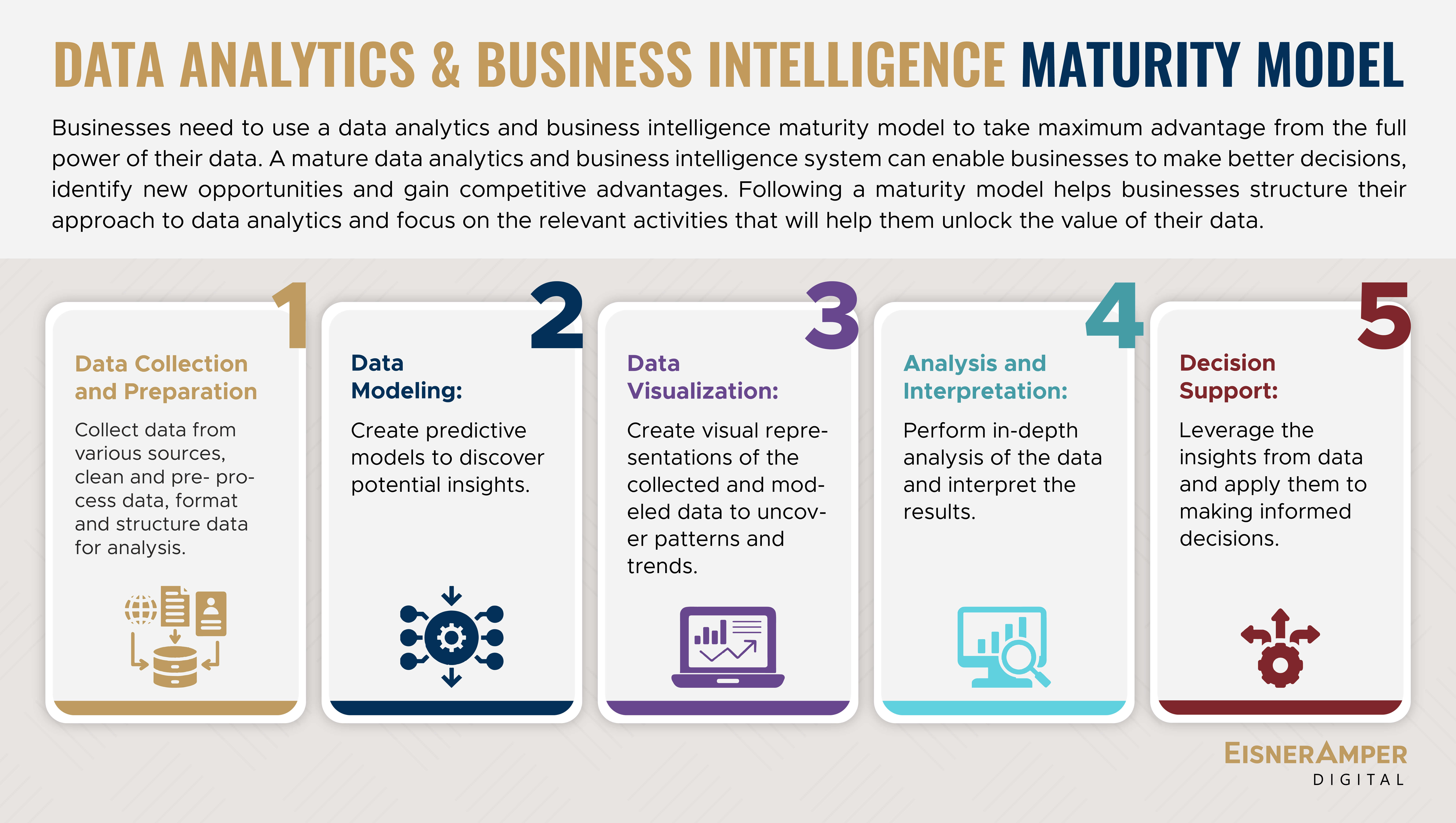
Step-by-Step Guide to Growing in a Data and Business Intelligence Maturity Model
- Published
- Feb 25, 2023
- Share
A data analytics and business intelligence (BI) maturity model is a framework that organizations can use to evaluate their current BI capabilities and identify areas for improvement. The model can be used to create a roadmap for growing and developing BI capabilities over time. This article will outline a step-by-step approach to growing in a data and BI maturity model.

Step 1: Assess Your Current Level of Data Analytics & BI Maturity
The first step in growing in a data and BI maturity model is to assess your current level of BI maturity. This involves evaluating your organization's current BI capabilities, including data management, data governance, data warehousing, reporting and analytics and data visualization. Identify areas where your organization is strong and areas that need improvement. Taking a data analytics readiness survey is important in this process because it allows for a comprehensive and objective evaluation of your organization's current data analytics capabilities. It helps to identify specific areas for improvement and guides the development of a tailored strategy for achieving greater data and BI maturity. Additionally, conducting regular readiness surveys can help track progress keep the organization on track to achieving its goals in data analytics.
Step 2: Identify Your BI Goals
The next step in is to identify your BI goals. These should align with your overall business goals and be specific, measurable, achievable, relevant and time-bound (SMART). This means that the goals should be clear and defined, have a measurable outcome, be achievable with the resources available, be relevant to the overall business objectives and have a specific deadline. By setting SMART goals, you can ensure that your BI efforts are aligned with your overall business strategy and that progress can be tracked and measured.
Some common BI goals include:
- Improving data quality: This means being as certain as possible that your data is accurate, complete and reliable. This can be achieved by implementing data governance and quality control processes.
- Increasing data accessibility: This means providing the right people access to the right data at the right time. This can be achieved by implementing data warehousing and reporting solutions that allow for easy access to data.
- Enhancing data-driven decision-making: This means using data and analytics to inform business decisions. This can be achieved by implementing advanced analytics and visualization tools to help business leaders make more informed decisions.
It's important for a business leader to understand that BI goals should be specific to the organization, and it's not just about having the latest technology, but also aligning the BI goals to the overall business objectives and being able to measure the progress and the impact of those goals.
Step 3: Create a BI Roadmap
Once you have identified your BI goals, creating a BI roadmap is the next step. A BI roadmap is a comprehensive plan that outlines the steps you need to take to achieve your BI goals, as well as the resources (people, processes and technology) that will be required. It serves as a guide for the organization to follow in order to achieve its BI goals and should be aligned with the overall business strategy.
The BI roadmap should include:
- A clear description of the BI goals and how they align with the overall business goals;
- A detailed plan of action that outlines the specific steps that need to be taken to achieve the BI goals;
- A list of resources required, such as personnel, technology and budget to implement the plan;
- A timeline for each step, including milestones and deadlines, so the plan is executed in a timely manner; and
- A regular review and update schedule so you have evidence that the roadmap remains aligned with the changing business and technology environment.
The BI roadmap should be a living document, meaning it should be constantly reviewed and updated to reflect the latest trends, changes in the business environment, and progress of the initiatives; it should also align with the overall business objectives. Additionally, the BI roadmap should be communicated to all stakeholders, including leadership, IT and business units so everyone is aware of the plan and their role in its execution.
Step 4: Implement Data Governance
Data governance is a critical component of BI maturity. This involves establishing policies and procedures for managing data, including data quality, security and privacy. It also includes setting up roles and responsibilities for data management and creating processes for data management, such as data warehousing, data integration, and data analysis.
Step 5: Invest in Data Management and Analytics Tools
Investing in data management and analytics tools is essential to growing in a data and BI maturity model. These tools can help automate data management processes, improve data quality and enable more advanced analytics. Some popular data management and analytics tools include data warehouse platforms, data visualization tools and data integration tools.
Step 6: Develop a Data-Driven Culture
Finally, to grow in a data and BI maturity model, developing a data-driven culture is essential. This involves creating an environment in which data is valued and data-driven decision-making is the norm. This includes providing training and education for employees, creating a data-literate work force and encouraging the use of data in decision-making.
Conclusion
Growing in a data and BI maturity model requires a holistic approach that includes assessing your current level of BI maturity, identifying your BI goals, creating a BI roadmap, implementing data governance, investing in data management and analytics tools and developing a data-driven culture. By following these steps, organizations can improve their BI capabilities and achieve better business outcomes.
Curious if your company is getting the most of its data? Take our Data Analytics Readiness Survey and start maximizing the value of your business intelligence and data analytics investments.
What's on Your Mind?
Start a conversation with Adam
Receive the latest business insights, analysis, and perspectives from EisnerAmper professionals.











